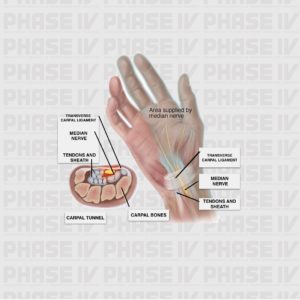Carpal Tunnel Syndrome:
By CEO Robert Forster, PT
 Although it is commonly thought carpal tunnel syndrome is a condition born from long hours spent working on a computer keyboard, it is actually most often a result of an accumulation of stress from a variety of common repetitive movements.
Although it is commonly thought carpal tunnel syndrome is a condition born from long hours spent working on a computer keyboard, it is actually most often a result of an accumulation of stress from a variety of common repetitive movements.
 Located on the palm side of your wrist the carpal tunnel is a narrow passageway bound by bones and ligaments, about as big around as your thumb. This tunnel protects a main nerve to your hand and nine tendons that bend your fingers. Strain on these tendons causes swelling and a resultant pressure placed on the nerve produces the numbness, pain and eventually hand weakness that characterize carpal tunnel syndrome.
Fortunately, for most people who develop carpal tunnel syndrome, conservative non-surgical treatment will usually relieve the pain and numbness and restore normal use of their wrists and hands.
Located on the palm side of your wrist the carpal tunnel is a narrow passageway bound by bones and ligaments, about as big around as your thumb. This tunnel protects a main nerve to your hand and nine tendons that bend your fingers. Strain on these tendons causes swelling and a resultant pressure placed on the nerve produces the numbness, pain and eventually hand weakness that characterize carpal tunnel syndrome.
Fortunately, for most people who develop carpal tunnel syndrome, conservative non-surgical treatment will usually relieve the pain and numbness and restore normal use of their wrists and hands.
Symptoms:
Carpal tunnel syndrome typically starts gradually with a vague aching in the wrist area that can extend into your hand or forearm.Other common symptoms include:
- Tingling or numbness in the fingers or hand, primarily in the thumb, index, middle or ring fingers, but not the little finger. This sensation often occurs while grasping a steering wheel, phone or newspaper or upon awakening. Many people “shake out” their hands to try to relieve their symptoms. As the disorder progresses, the numb feeling may become constant.
- Pain radiating or extending from your wrist up your arm to your shoulder or down into your palm or fingers, especially after forceful or repetitive use. This usually occurs on the palm side of your forearm.
- A sense of weakness in your hands and a tendency to drop objects.
When to seek help:
If you have persistent signs and symptoms that might be due to carpal tunnel syndrome that interfere with your normal activities – including sleep you should call for a physical therapy evaluation to confirm the diagnosis and begin treatment. If you leave the condition untreated, nerve and muscle damage can occur.Treatment:
Treatment will focus on the specific causes of Carpal Tunnel Syndrome with the goal of decompressing the nerve traversing the wrist and restoring function.Physical therapy treatment for Carpal Tunnel Syndrome consists of:
- Manual therapy: including joint mobilization, and advanced massage techniques to improve function of the forearm and wrist
- Stretching and Strengthening Exercises to improve the bio-mechanics of the joints
- Ergonomic and Postural training and education to reduce stress on the wrist in home and work environments. This includes the computer workstation and addressing any repetitive motions in work, hobbies and recreational activities
- Wrist splinting in a neutral position if necessary
Physical Therapy Modalities:
- Ultrasound to increase tissue extensibility, improve blood flow and to administer medication through the skin
- Electrical stimulation to decrease swelling, inflammation and pain
- Ice or ice massage to decrease inflammation at the carpal tunnel







